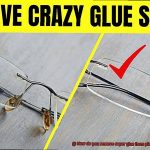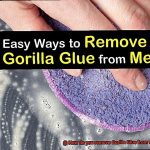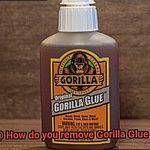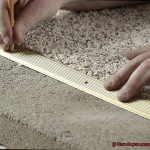We all love experimenting with different hairstyles and wigs to rock fabulous looks. But let’s be real – dealing with hair glue can quickly turn into a sticky nightmare. Don’t worry, though, because we’ve got your back.
In this blog post, we’ll spill the beans on safe and effective techniques to bid farewell to that pesky hair glue residue without damaging your precious tresses.
From secret homemade remedies to trusty store-bought products, we’ll guide you through the best methods for removing hair glue from your locks right in the comfort of your own home.
So sit tight, relax, and get ready to regain your luscious mane without a trace of that stubborn adhesive. Let’s dive in and finally conquer those glue-induced hair headaches once and for all.
What is Hair Glue and How Does it Work?
Contents
- 1 What is Hair Glue and How Does it Work?
- 2 Common Methods for Removing Hair Glue at Home
- 3 Using Oil-Based Products to Remove Hair Glue
- 4 Using a Commercial Adhesive Remover to Remove Hair Glue
- 5 Using Vinegar to Remove Hair Glue
- 6 Tips and Tricks for Removing Hair Glue at Home
- 7 Be Patient and Gentle When Removing the Glue from Your Hair
- 8 Use a Wide-Toothed Comb or Detangling Brush to Help Remove the Glue
- 9 Thoroughly Wash and Condition Your Hair After Removing the Glue
- 10 Conclusion
The secret lies in the power of hair glue. In this ultimate guide, we’ll dive into the world of hair glue, exploring its purpose, composition, and how it works to create flawless hairstyles.
What is Hair Glue?
Hair glue, also known as adhesive or bonding glue, is a specially formulated adhesive designed for use in hair extensions and wigs. Crafted with a potent blend of polymers and solvents, this magical concoction creates a sticky and durable bond that keeps hairpieces securely in place.
How Does it Work?
To achieve a strong bond, start by ensuring both your natural hair and the hairpiece are clean and free from oils or residue. This paves the way for a more reliable connection between the two surfaces.
Next, apply the hair glue directly to the hairpiece or weft, pressing it onto your natural hair with precision.
As the glue cures, it hardens, forming an unbreakable bond that ensures your hairpiece stays put throughout the day.
Tips for Safe Application:
- Thoroughly cleanse your natural hair to eliminate any oils or residue.
- Use a small amount of glue to avoid excessive product buildup.
- Apply thin layers of glue for better control and even distribution.
- Allow sufficient curing time to guarantee a strong bond.
Removal Techniques:
When it’s time to say goodbye to your hair extensions or wig, proper removal techniques are crucial to maintaining healthy hair. Here are some effective methods for removing hair glue at home:
- Oil-Based Products: Generously apply coconut oil or olive oil to break down the glue. Massage it into the affected area and gently remove with a comb or fingers.
- Commercial Adhesive Removers: These specialized products dissolve adhesives. Follow the instructions carefully and comb or brush through your hair to remove the dissolved glue.
- Vinegar: The acidic nature of vinegar aids in breaking down the glue. Mix equal parts vinegar and water, spray it onto the affected area, let it sit, and gently remove the softened glue.
Tips for Removal:
- Be patient and gentle to avoid damaging your hair.
- Use a wide-toothed comb or detangling brush to separate strands and ease glue removal.
- Thoroughly wash and condition your hair after glue removal to eliminate residue and restore moisture.
Common Methods for Removing Hair Glue at Home
In this comprehensive guide, we’ll explore some of the most common methods for removing hair glue at home. So grab your favorite oil or natural remedy, and let’s get started.
One of the most effective ways to remove hair glue is by using oil-based products such as baby oil, coconut oil, or even olive oil. These oils work by breaking down the adhesive properties of the glue, making it easier to remove.
To use this method, apply a generous amount of oil to the affected area and gently massage it into the hair glue. Let it sit for a few minutes to allow the oil to dissolve the glue, then rinse your hair thoroughly with warm water and shampoo.
If you’re looking for a stronger solution, acetone or nail polish remover can be used to remove hair glue. However, be cautious as acetone can be harsh on the scalp and hair. Dilute the acetone with water or mix it with a mild shampoo before applying it to the hair.
Gently massage it in and let it sit for a few minutes before rinsing thoroughly. Remember to condition your hair afterwards to minimize any potential damage.
For those with sensitive scalps, natural remedies like vinegar or lemon juice can be gentler alternatives. These acidic substances can help soften and dissolve the hair glue. Dilute vinegar with water and apply it to the glued area, massaging it in gently.
Let it sit for a few minutes before rinsing your hair thoroughly with warm water and shampoo. Alternatively, you can directly apply lemon juice to the hair glue and let it sit for a few minutes before rinsing.
Another effective method for removing hair glue is by using heat. Heat can help soften and loosen the adhesive properties of the glue, making it easier to scrape or peel off.
Use a blow dryer or a hot towel to apply heat to the glued area, keeping the heat at a moderate level to avoid damaging your hair. Gently scrape or peel off the softened glue using your fingers or a comb.
Remember, patience is key when removing hair glue at home. Avoid forcefully pulling or tugging on the hair, as this can cause damage. If these methods don’t work or if you have concerns about your hair or scalp, it’s best to consult a professional hairstylist for assistance.
Using Oil-Based Products to Remove Hair Glue
In this guide, we’ll explore the wonders of oil-based products, particularly coconut oil, and how they can help you remove hair glue effectively and safely. Whether you’re a seasoned DIY enthusiast or simply looking for a cost-effective solution, these steps will have your hair glue-free in no time.
Step 1: Prep Your Hair
To start, apply a generous amount of coconut oil to the affected areas of your hair. Thoroughly massage the oil into your hair, ensuring that the glue is thoroughly coated.
Step 2: Wait and Relax
Cover your hair with a shower cap or plastic wrap to create a warm environment. Leave the oil on for approximately 30 minutes to allow it to penetrate the glue and soften its hold on your strands. Take this time to unwind and pamper yourself – maybe catch up on your favorite TV show or delve into a good book.
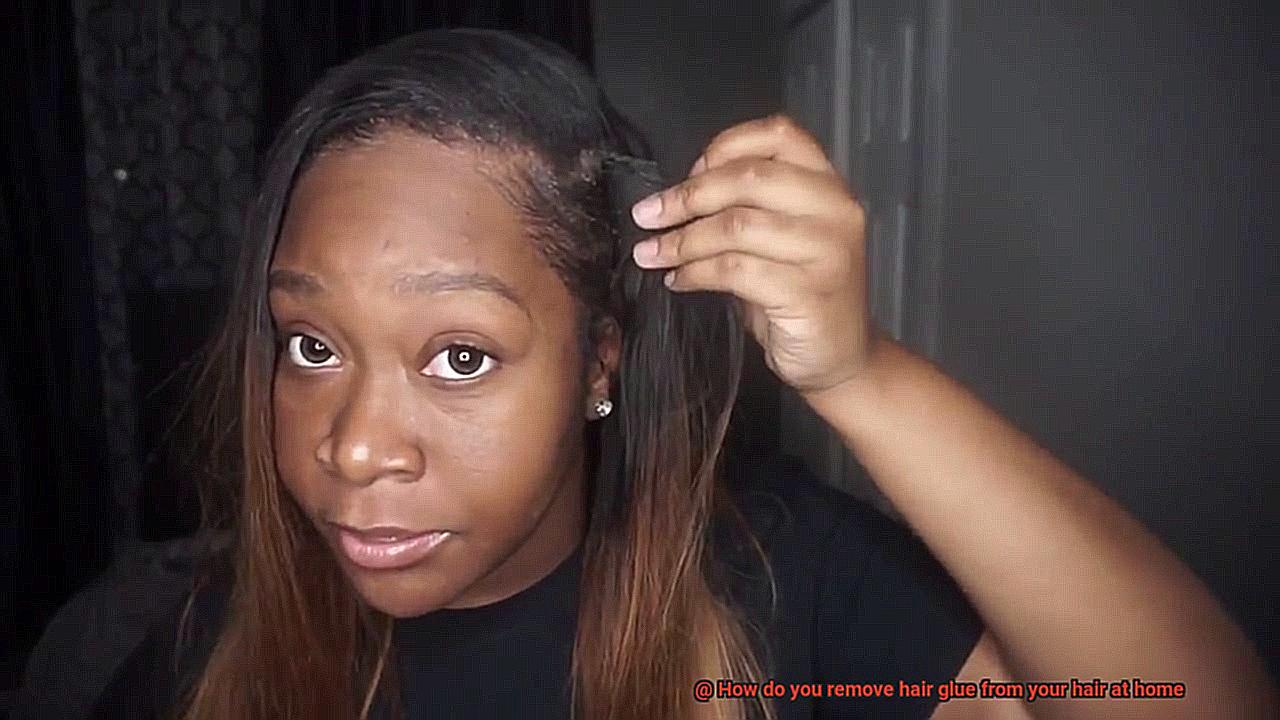
Step 3: Comb It Out
After the waiting period, remove the shower cap and grab a wide-toothed comb or use your fingers to gently comb through your hair. You’ll notice how the softened glue starts to come off more effortlessly, allowing you to remove it without causing any damage.
Step 4: Repeat if Necessary
Depending on the amount of glue present in your hair, you may need to repeat the process multiple times. Remember not to rush or pull too hard on your strands, as this can lead to breakage. Patience is key.
Step 5: Wash and Condition
Once you’ve successfully removed all traces of hair glue, it’s crucial to wash and condition your hair thoroughly. This step ensures that any residue from the oil-based products is removed, leaving your hair clean and free from any remaining glue.
Using a Commercial Adhesive Remover to Remove Hair Glue
Well, fret no more. Using a commercial adhesive remover is the ultimate solution to your hair glue woes. Whether you’re a seasoned stylist or an enthusiastic DIY-er, this method is both simple and effective.
So, let’s dive into the fascinating process of using a commercial adhesive remover to bid farewell to that pesky hair glue once and for all.
First things first, what exactly is a commercial adhesive remover? It’s a carefully formulated product specifically designed to break down and dissolve strong adhesives. These miraculous removers come in various forms such as sprays, liquids, gels, or wipes, allowing you to choose the one that suits your personal preference. You can find them conveniently at beauty supply stores or order them online from the comfort of your own home.
Now that you have your trusty adhesive remover in hand, it’s crucial to select a high-quality one that is safe for use on both your hair and skin. Take a moment to carefully read the label and look for one that explicitly mentions hair glue removal.
To commence the magical removal process, generously apply the adhesive remover directly onto the areas of your hair that are plagued by glue. With gentle yet purposeful motions, massage the remover into your hair, allowing it to work its magic for a few minutes. This time is essential as it grants the remover the opportunity to penetrate and loosen the stubborn grip of the glue.
Next, armed with a comb or your nimble fingers, delicately work through your hair, gradually separating the strands and triumphantly removing any loosened glue along the way. If necessary, don’t hesitate to reapply the adhesive remover and repeat this victorious process until every last trace of glue has been banished from your tresses. Remember, patience is key here – take your time to avoid any unintended damage to your beloved locks.
It’s important to note that commercial adhesive removers, while powerful allies in your quest for hair glue liberation, may come with some risks. The possibility of skin irritation or allergic reactions exists, so it’s always wise to perform a patch test before embarking on a full-scale application of the remover.
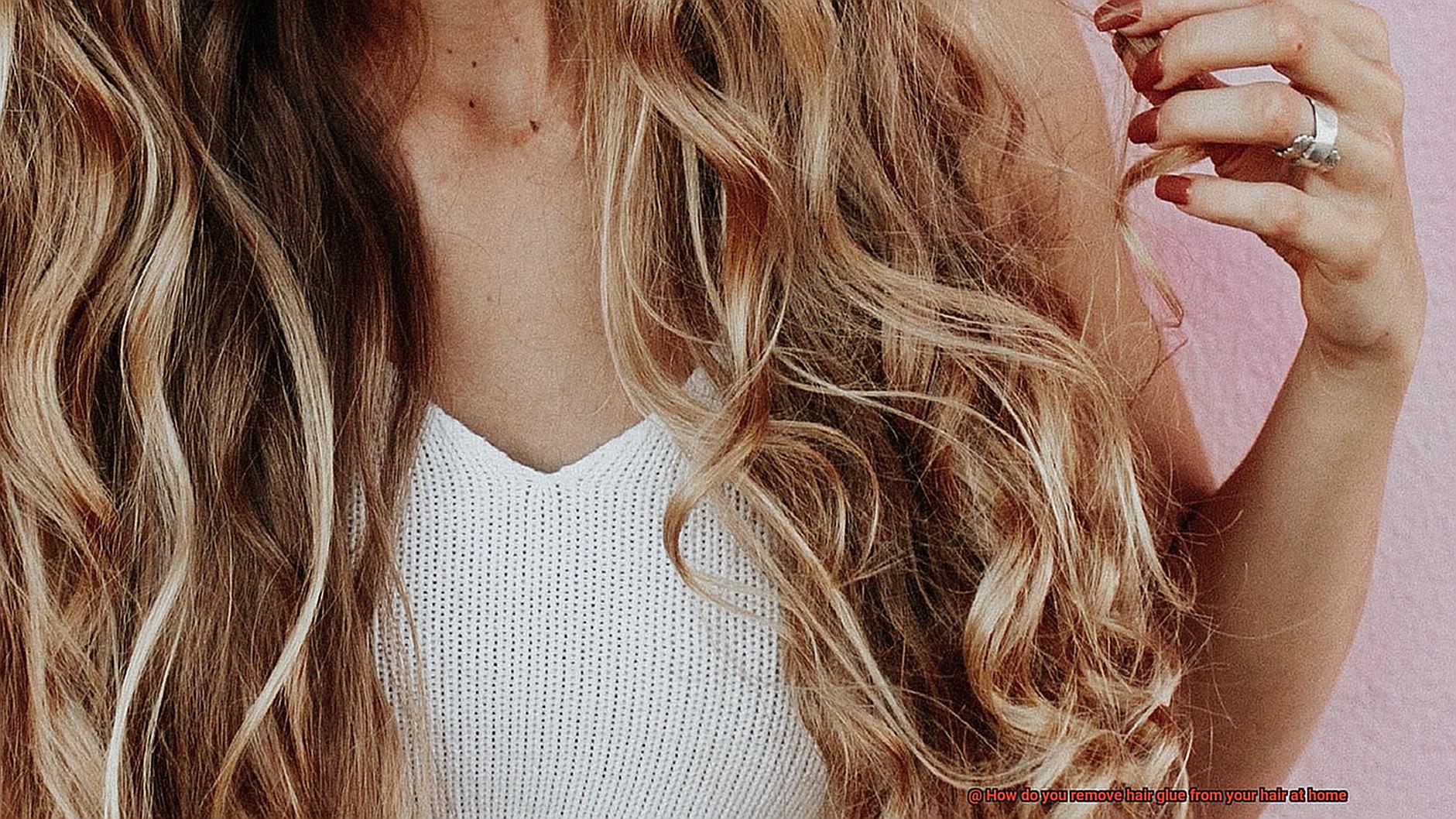
Once you’ve successfully bid adieu to the hair glue that once held you captive, it’s time to pamper your hair. Treat it to a luxurious deep conditioning treatment or a revitalizing hot oil treatment to restore moisture and nourishment, ensuring it emerges from this battle stronger and more glorious than ever before.
Using Vinegar to Remove Hair Glue
Well, fear not, because I have the ultimate solution for you – vinegar. This common household ingredient can be your secret weapon in the war against hair glue.
Vinegar works its magic thanks to its natural acidity. This acidity has the power to break down the adhesive properties of hair glue, making it easier to remove. It’s like a superhero swooping in to save the day.
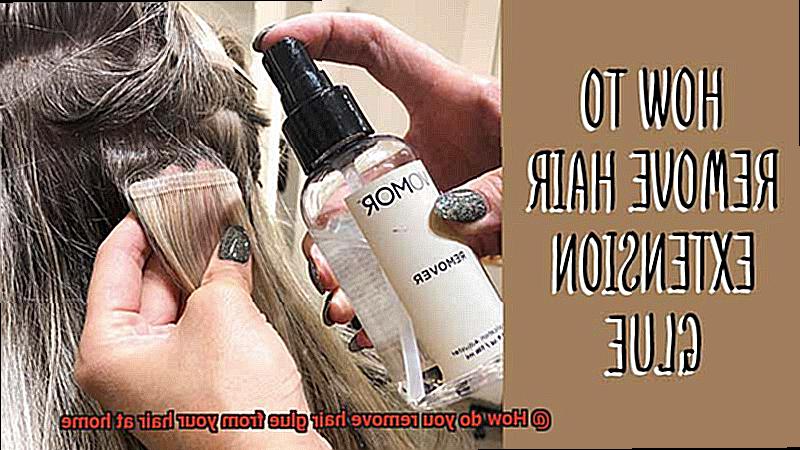
Now, let’s dive into the step-by-step process of using vinegar to remove hair glue:
- Grab a bowl and mix equal parts vinegar and warm water. This creates a potent yet gentle solution that will tackle that pesky glue head-on.
- Take a towel or cotton pad and soak it in the vinegar solution. Make sure it’s fully saturated but not dripping. We want just the right amount of power.
- Gently dab the soaked towel or cotton pad onto the areas with hair glue. Be careful not to rub too forcefully; we don’t want any unnecessary hair casualties.
- Let the vinegar solution work its magic for about 10-15 minutes. During this time, it will penetrate and loosen that stubborn glue, preparing it for removal.
- After the waiting game, grab a wide-toothed comb and gently comb through your hair. The loosened glue should start to come off with ease, like a weight lifted off your shoulders.
- Rinse your hair thoroughly with warm water to remove any remaining vinegar residue and leftover glue particles. We want a clean slate, after all.
Now, here’s a little secret: vinegar may not completely banish all traces of hair glue on the first attempt, especially if it’s been slathered on thickly. But don’t worry. Just repeat the process if needed – persistence is key.
Lastly, show your hair some love by following up with a deep conditioning treatment. This will restore moisture and nourishment to your locks, leaving them looking fabulous and glue-free.
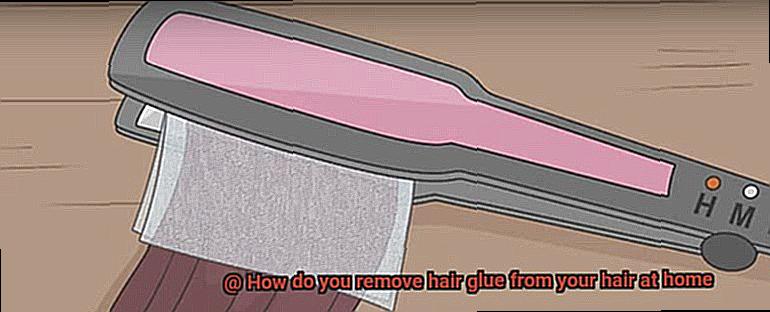
Remember, my glue-busting friends, while vinegar is generally safe for most hair types, it’s always wise to do a patch test before going all-in. We want to avoid any surprises or unwanted reactions, right?
Tips and Tricks for Removing Hair Glue at Home
Removing hair glue at home can be a challenging task, but with the right tips and tricks, you can achieve gentle and effective removal without causing damage to your hair or scalp. It is crucial to use the correct products and techniques to ensure a successful removal process. In this article, we will explore some helpful tips and tricks for removing hair glue at home.
Soften the Glue with Oil:
The first step in removing hair glue is to soften it. Apply a generous amount of oil, such as coconut oil or olive oil, to the affected area. The oil helps break down the adhesive properties of the glue, making it easier to remove. Let the oil sit on your hair for about 30 minutes to an hour, allowing it to penetrate the glue and loosen its grip on the hair strands.
After letting the oil work its magic, gently comb through your hair using a wide-toothed comb or your fingers. This helps separate and remove any loosened glue without causing breakage or damage. Be patient and avoid pulling or tugging too forcefully on your hair.
Consider Specialized Adhesive Removers:

For stubborn or excessive glue buildup, consider using a specialized adhesive remover. These products are specifically designed to dissolve hair glue without harming your hair. Follow the instructions provided with the remover and use it sparingly to avoid any potential damage.
Cleanse and Condition:
After removing the hair glue, thoroughly cleanse your hair using a clarifying shampoo or a sulfate-free shampoo. These shampoos effectively remove build-up without stripping away essential oils from your scalp and hair. Follow up with a deep conditioning treatment or mask to restore moisture and improve the overall health of your hair.
Prevention is Key:
To avoid excessive hair glue buildup in the future, carefully read and follow the instructions provided with your hair extensions or wigs. These instructions often include tips on how to properly apply and remove hair glue. By following them, you can prevent future issues and make the removal process easier.
Seek Professional Help if Needed:
If you’re having difficulty removing the hair glue at home or if there is significant hair damage, don’t hesitate to seek professional help. A hairstylist who specializes in hair extensions or weaves can provide expert advice and assistance in resolving any issues related to hair glue removal.
Be Patient and Gentle When Removing the Glue from Your Hair
Getting glue stuck in your hair can be a sticky situation, but don’t panic. Whether it’s from a craft mishap or a beauty accident, removing glue from your hair requires patience and gentleness to avoid damaging your precious strands. This article will guide you through the importance of being patient and gentle when removing glue from your hair, providing expert tips and tricks for a safe and effective removal process.
Softening the Glue:
Start by generously applying oil or conditioner to the glued area. This step is crucial as it softens the glue, making it easier to remove. Gently massage the oil or conditioner into the glued area, using your fingers to work it in. Allow it to sit for a few minutes to further loosen the glue.
Separating the Strands:
Carefully separate the strands of hair that are stuck together due to the glue. Avoid pulling or tugging on the hair, as this can cause pain and potential hair loss. Take your time, be patient, and gently work your way through the glued area with a wide-toothed comb or your fingers. Untangle the hair without causing any further damage.
Dealing with Stubborn Patches:
Encountering stubborn patches of glue? Don’t fret. Apply more oil or conditioner and continue massaging until the glue loosens. Remember, patience is key during this process. Take breaks if needed and repeat the steps until all the glue is removed.
Washing and Conditioning:
After successfully removing all the glue, wash your hair thoroughly with a gentle shampoo and conditioner to remove any residue. Leftover glue can weigh down your hair and make it look dull, so ensure you cleanse it properly.
Nourishing and Repairing:

The glue removal process can be drying for your hair. Therefore, apply a deep conditioning treatment to nourish and repair your strands. Replenish moisture and restore your hair’s vitality by giving it the nourishment it needs.
Use a Wide-Toothed Comb or Detangling Brush to Help Remove the Glue
Dealing with sticky residue from hair glue can be an absolute nightmare. But fret not. With the right tools and techniques, you can effectively remove hair glue without causing any damage or breakage. In this comprehensive guide, we will lead you step-by-step through the process of using a wide-toothed comb or detangling brush to effortlessly eliminate that stubborn glue. So, let’s jump right in.
Step 1: Prep Your Hair
- Begin by generously applying oil or conditioner to the glued area.
- Allow it to sit for a few minutes, allowing the glue to soften and become more manageable.
Step 2: Untangle with Finesse
- Gently comb or brush your hair from the ends to the roots.
- Opt for a wide-toothed comb or detangling brush for optimal results.
- Take your time and exercise patience. Avoid any harsh pulling or tugging, as this can cause pain and potential damage.
Step 3: Conquer Stubborn Spots
- Encountering resistance? Don’t force the comb or brush through your hair.
- Instead, apply more oil or conditioner to the tangled area.
- Use your nimble fingers to delicately work through the spot until the tangles surrender.
Step 4: Divide and Conquer
- Divide your hair into manageable sections.
- Tackle one section at a time, ensuring comprehensive coverage.
Step 5: Bid Adieu to Loosened Glue
- As you comb or brush through, observe how some of the glue starts to loosen and detach.
- Skillfully use your fingers to gently remove any liberated glue from the hair strands.
Step 6: A Meticulous Removal Process
- Continue combing or brushing until every last trace of glue has been banished.
- Be thorough in your approach and meticulously examine for any remnants or sticky patches.
Step 7: Cleanse and Condition
- After successfully eliminating the glue, wash your hair with a clarifying shampoo to remove any residual oil, conditioner, or residue.
- Follow up with a nourishing conditioner to replenish and hydrate your luscious locks.
Step 8: Dry with Care
- Allow your hair to air dry gracefully, or if needed, use a blow dryer on a low heat setting.
- Remember to steer clear of high heat, as it can inflict further damage upon your precious strands.
Thoroughly Wash and Condition Your Hair After Removing the Glue
Thoroughly washing and conditioning your hair after removing hair glue is crucial for maintaining healthy, beautiful locks. This step is essential in removing any residue left behind and restoring your hair’s natural texture. By following these steps, you can ensure that your hair remains free from damage and looks fabulous.
To begin, wet your hair thoroughly with warm water. This helps to loosen any remaining glue and makes it easier to remove. Next, apply a clarifying shampoo specifically formulated to eliminate residue. Massage the shampoo into your scalp, focusing on the areas where the glue was applied. Rinse your hair thoroughly with warm water, ensuring that all traces of shampoo are gone.
After removing the glue, it’s time to condition your hair. Choose a deep-conditioning treatment or a conditioner designed for damaged hair. Apply the conditioner evenly throughout your locks, paying extra attention to the ends, which tend to be drier. Leave the conditioner on for the recommended time stated on the product’s instructions. For added effectiveness, cover your hair with a shower cap or warm towel to create a steam effect that helps the conditioner penetrate deeper.
Once the recommended time has passed, rinse your hair with cool water. This seals the cuticles and leaves your strands smoother and less prone to damage.
Gently pat-dry your hair with a towel, avoiding any rubbing that can lead to frizz and breakage. If possible, allow your hair to air dry naturally. If using a blow dryer, use the lowest heat setting to minimize heat damage.
To maintain healthy hair in the long run, establish a regular hair care routine. Use sulfate-free products to avoid stripping away natural oils.
Limit excessive heat styling and consider incorporating nourishing oils or masks into your routine for added hydration and strength.
vLKuYF1EIto” >
Also Read: How To Remove Glue In Hair Extensions?
Conclusion
Removing hair glue from your hair at home can be a challenging task, but with the right techniques and products, it is definitely possible. It’s important to approach this process with caution and patience to avoid causing any damage to your hair. Here are some effective methods you can try:
- Oil-based removers: Start by applying a generous amount of oil, such as coconut or olive oil, to the glued areas of your hair. Let it sit for about 10-15 minutes to allow the glue to loosen. Then gently comb through your hair using a wide-toothed comb to remove the softened glue.
- Acetone: If you’re dealing with stubborn hair glue, acetone can be an effective solution. However, it’s important to use it sparingly and avoid contact with your scalp as it can cause irritation. Soak a cotton ball in acetone and carefully dab it onto the glued areas of your hair. Allow it to sit for a few minutes before gently combing through your hair.
- Citrus-based solvents: Another option is using citrus-based solvents like lemon juice or orange oil. These natural solvents can help break down the adhesive properties of the glue. Apply them directly onto the affected areas and let them sit for a few minutes before combing through your hair.
- Warm water and shampoo: For less stubborn cases of hair glue, simply washing your hair with warm water and shampoo may do the trick. Massage the shampoo into your hair, paying extra attention to the glued areas, and rinse thoroughly.
Remember to always follow up with a deep conditioning treatment after removing the glue from your hair to restore moisture and prevent any potential damage.
In conclusion, removing hair glue at home requires patience and careful handling of your locks. Whether you choose oil-based removers, acetone, citrus-based solvents, or just warm water and shampoo, take your time and be gentle.


